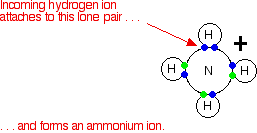The Arrhenius Theory of acids and bases
The theory
- Acids are substances which produce hydrogen ions in solution.
- Bases are substances which produce hydroxide ions in solution.
Limitations of the theory
Hydrochloric acid is neutralised by both sodium hydroxide solution and ammonia solution. In both cases, you get a colourless solution which you can crystallise to get a white salt - either sodium chloride or ammonium chloride.
These are clearly very similar reactions. The full equations are:
In the sodium hydroxide case, hydrogen ions from the acid are reacting with hydroxide ions from the sodium hydroxide - in line with the Arrhenius theory.
However, in the ammonia case, there don't appear to be any hydroxide ions!
You can get around this by saying that the ammonia reacts with the water it is dissolved in to produce ammonium ions and hydroxide ions:
This is a reversible reaction, and in a typical dilute ammonia solution, about 99% of the ammonia remains as ammonia molecules. Nevertheless, there are hydroxide ions there, and we can squeeze this into the Arrhenius theory.
However, this same reaction also happens between ammonia gas and hydrogen chloride gas.
In this case, there aren't any hydrogen ions or hydroxide ions in solution - because there isn't any solution. The Arrhenius theory wouldn't count this as an acid-base reaction, despite the fact that it is producing the same product as when the two substances were in solution. That's silly
The Bronsted-Lowry Theory of acids and basesThe theory
The Bronsted-Lowry theory doesn't go against the Arrhenius theory in any way - it just adds to it. Hydroxide ions are still bases because they accept hydrogen ions from acids and form water. An acid produces hydrogen ions in solution because it reacts with the water molecules by giving a proton to them. When hydrogen chloride gas dissolves in water to produce hydrochloric acid, the hydrogen chloride molecule gives a proton (a hydrogen ion) to a water molecule. A co-ordinate (dative covalent) bond is formed between one of the lone pairs on the oxygen and the hydrogen from the HCl. Hydroxonium ions, H3O+, are produced.  | |
Note: If you aren't sure about co-ordinate bonding you should follow this link. Co-ordinate bonds will be mentioned several times over the course of the rest of this page.Use the BACK button on your browser to return quickly to this page. | |
| When an acid in solution reacts with a base, what is actually functioning as the acid is the hydroxonium ion. For example, a proton is transferred from a hydroxonium ion to a hydroxide ion to make water. Showing the electrons, but leaving out the inner ones:  The hydrogen chloride / ammonia problem This is no longer a problem using the Bronsted-Lowry theory. Whether you are talking about the reaction in solution or in the gas state, ammonia is a base because it accepts a proton (a hydrogen ion). The hydrogen becomes attached to the lone pair on the nitrogen of the ammonia via a co-ordinate bond.  If the reaction is happening in the gas state, the ammonia accepts a proton directly from the hydrogen chloride: Either way, the ammonia acts as a base by accepting a hydrogen ion from an acid. | |


We also provide analytical services and laboratory services to our customers. Products listed on our website are either in stock or can be resynthesized within a reasonable time frame. Phosphonium ionic liquids
ReplyDelete